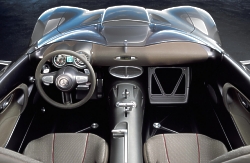|

The Web
for Automotive Professionals & Car Enthusiasts
Models:





















Privacy
Statement
© 1998 - 2007
Copyright &
Disclaimer
Automotive Intelligence,
www.autointell.com
All Rights Reserved .
For questions please contact
editor@autointell.com
|
Mercedes-Benz: F400 Carving
DaimlerChrysler presents F 400 Carving
research vehicle with dynamic chassis technology at the Tokyo Motor
Show 2001



DaimlerChrysler is exhibiting a special concept
study at the 35th Tokyo Motor Show: the F 400 Carving is a research
vehicle packed with dynamic systems designed to give the cars of tomorrow
and beyond substantially enhanced active safety, dynamic handling control
and driving pleasure.
The main attraction in the F 400 Carving is
a new system that varies the camber angle on the outer wheels
between 0 and 20 degrees, depending on the road situation.
|
|

Click
image for larger view
Used
in conjunction with newly-developed tyres, it provides 30 percent
more lateral stability than a conventional system with a fixed
camber setting and standard tyres.
This considerably enhances active safety,
since better lateral stability equals improved road adhesion
and greater cornering stability.
|

Click image for larger view
|

Click image for larger view
|
Active camber control boosts the research
vehicle's maximum lateral acceleration to 1.28 g, meaning that
the concept study outperforms current sports cars by some 28
percent.
The active camber control in the F
400 Carving paves the way for an equally new asymmetrical-tread
tyre concept. When the two-seater car is cornering, the outer
wheels tilt inwards, leaving only the inner area of these tyres
in contact with the road. This area of the tread is slightly
rounded off. Meanwhile both the tread pattern and the rubber
blend have been specially selected to ensure highly dynamic
and extremely safe cornering.
|
When driving straight ahead, however,
it is the outer areas of the tyres that are in contact with the road.
These areas have a tried-and-tested car tread pattern, offering excellent
high-speed and low-noise performance. Two different concepts therefore
come to fruition in a single tyre, thanks to active camber control.
.
|
|
|

Click image for larger view
|
The research vehicle's "Carving" epithet symbolises
the new technology, evoking images of the high-speed winter
sport in which adepts perform sharp turns on a specially-shaped
high-grip ski.
Less risk of skidding and shorter emergency stopping distance
The F 400 Carving is something of a mobile
research laboratory for the Stuttgart-based automotive engineers.
They will be using it to investigate the undoubted further potential
of this new chassis technology: besides offering excellent
directional stability during cornering, the new technology ensures a
much higher level of active safety in the event of an emergency. By
way of example, if there is a risk of skidding, the wheel camber is
increased by an appropriate degree.
|
The resultant gain in lateral
stability significantly enhances the effect of ESP®, the Electronic
Stability Program. If the research car needs to be braked in an emergency,
all four of its wheels can be tilted in next to no time, thus shortening
the stopping distance from 100 km/h by a good five metres.
|

Click image for larger view |
Electronic steering, active hydropneumatic system and light from
glass fibres
In addition to active camber control, the F 400 Carving research
car is fitted with other forward-looking steering and chassis systems,
including a steer-by-wire system. Sensors pick up the driver's steering
inputs and send this information to two microcomputers which, in turn,
control an electrically driven steering gear. The DaimlerChrysler engineers
also charted new territory when it came to the suspension tuning, and
introduced a first: an active hydropneumatic system that optimises the
suspension and shock absorption in line with the changing situation
on the road, all at lightning speed.
The F 400 Carving is also the showcase for a totally new form of
lighting technology developed by the Stuttgart-based researchers: fibre-optic
lines are used to transmit light from xenon lamps beneath the bonnet
to the main headlamps. This technology stands out by virtue of its high
performance and extremely space-saving design. Additional headlamps
positioned on the sides also come on when the car is cornering.
|
Exciting design symbolising innovation and emotion
The F 400 Carving is an exciting and harmonious blend of technology
and design. The shape of the sports car - notably its distinctive wing
profiles - provides the necessary room for the wheels to move when the
active camber control is at work during cornering and, at the same time,
emphasises the youthful and highly-adventurous nature of this concept
study. In order to reflect the research car's high-quality driving dynamics,
the designers opted for a speedster concept - incorporating an extended
bonnet, a windscreen with an extremely sharp rake, a short tail end
and an interior tailor-made for two.
Photos: Mercedes
top
|